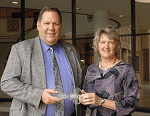2009 Campus Technology Innovators: Enterprise Resource Planning
- By Mary Grush, Matt Villano
- 08/01/09

IN KEEPING WITH the positive vibes maintained throughout Project KEYS, team members were
given "keys" to commemorate the ERP system completion. Pictured: project leads Ed Mahon
and Roberta Sikula-Schwalm.
ENTERPRISE RESOURCE PLANNING
Innovator: Kent State University
This Ohio institution implemented a robust ERP solution
across eight campuses-- and thanks to smart planning
and teamwork, kept the 30-month project on time and
on budget.
On the surface, Project KEYS at Kent State University (OH) was a $23 million, 30-month project to roll out the Banner
Enterprise Resource Planning (ERP) solution from Sun-
Gard across eight different campuses. Beyond the technology,
however, what made Project KEYS (which stands for "Kent
State: ERP is Your Solution") so innovative was the process
behind it, and the model university technologists developed
for implementation.
To get the job done, Project
KEYS team members
worked together boot-campstyle
in an old bus garage
off campus.
According to Roberta Sikula-Schwalm, associate vice president
of the school's Information Services department, the
overall goal was to bring the project in on time and on budget,
as well as implement enhanced functionality within a highly
robust portal.
To meet these needs, Kent State deployed full-time project
management and business analysts to navigate the ERP implementation
from beginning to end. All told, the university
engaged 70 full-time technicians and functional end users and
put them together in a boot camp environment to get the job
done. That team-- comprised of 55 Kent State staffers and
15 SunGard employees, headed by Ed Mahon, the school's
VP and CIO-- got
together in an old
bus garage several
miles off campus.
Sequestered away from the rigors of everyday work, participants
strategized a step-by-step plan of attack, engineered
improvements for the technology, and worked together to keep
the project on track.
Through the process, participants developed a sense of
camaraderie, growing to understand each other better
and gain a broader sense of different roles within
the organization. "This relationship enabled us to get
through tough decisions and tough moments in an
efficient, professional manner that never caused project
slowdown or stoppage," says Sikula-Schwalm.
"Technical personnel became more knowledgeable
about functional business processes, and functional
personnel gained more knowledge about technical
jargon and how the system worked."
Also key to the project's success: The time frame
for each module implementation ranged from 12-18
months, calling for a relatively short-term expenditure
of time and energy by project staff. The time frame
allowed team members to fully focus and manage
project stress, says Sikula-Schwalm. "When projects
go on for years, staff burnout is often extensive and
product output not always at the level desired."
Instead, as she describes, "The mood within Project
KEYS was relaxed and often playful."
Over the course of the project, subgroups of
technicians focused on augmenting the university's
portal to authenticate a variety of best-of-breed
third-party software solutions such as Kronos (for time keeping and attendance reporting),
SciQuest (for eProcurement), Cognos (for
business intelligence reporting), and PeopleAdmin
(for human resources management),
to name a few.
The Project KEYS team also worked to
guarantee that the finished product went live
with integrated workflows, imaging technology,
and sophisticated reporting capabilities,
making the new ERP system bigger, better,
and more efficient than its predecessor.
The project concluded in June 2008, when
Kent State's Unified Digital Campus launched
fully operational across the Human Resources,
Finance, Student, and Financial Aid modules.
So far, the results of this improvement have
been exemplary. Sikula-Schwalm notes that
being able to go live with significant functionality
across all Banner modules-- including
workflows, imaging, reporting, and significant
self-service applications-- improved efficiency
and reduced pushback from faculty, staff,
and the administration.
She adds that on a practical level, the new system has
expanded the school's ability to manage data across the
board; the reporting environment in particular has greatly
expanded Kent State's ability to determine ROIs, and the
workflow and imaging tools have enabled IT personnel to
monitor the benefits of becoming paperless.
Over the last year, the school has updated system functionality
monthly, and Sikula-Schwalm says more improvements
are on the way. "We are continuing to expand the portal
environment by enhancing existing applications and developing
new self-service opportunities," she notes. Among those
areas targeted for improvement: identity management, enrollment
management, and fiscal advisement.
About the Authors
Mary Grush is Editor and Conference Program Director, Campus Technology.
Matt Villano is senior contributing editor of this publication.